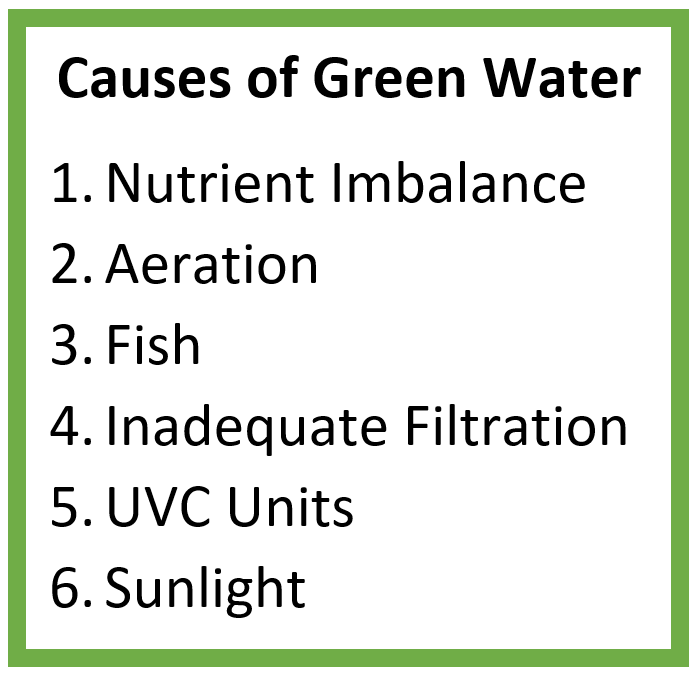Green Water and Slimy Algae

1. Nutrient Imbalance (Useful Blogs: New Pond Syndrome, Water Quality, Pond Sludge)
If your pond is new or you have recently performed a water change, then your pond may be out of balance. Every time a water change is performed, it takes time for the water to rebalance the ammonia, nitrites and nitrates, which is why it's best to avoid changing your pond water. Green water is not necessarily an indication of bad water quality, only a test can prove this. If you need to add water to your pond, use rain water or dechlorinated tap water.
Algae will feed off of excess nutrients (ammonia, nitrites, and nitrates) in your pond, so controlling these is important. Another source of these chemicals is sludge, formed from rotting organic matter (like waste and food). Manually removing the sludge with a net, treatment or a vacuum will help, but you should explore the cause. We always recommend that people ensure they have a suitable pump and filter system, which can keep sludge at bay.
2. Aeration (Useful Blogs: Aeration, Pond Plants)
Aerating your pond boosts your pond's ecosystem by increasing the healthy bacteria in your pond, keeping your pond balanced and reducing algae development. The healthy bacteria balances various chemicals in the water (notably ammonia, nitrites and nitrates), which prevents algae blooms as the algae will have fewer nutrients and its reproductivity severely hampered.
Aerating a pond can be easy and stylish; from adding a waterfall or a fountain or adding plants. Plants compete with algae for the pond's chemicals, which prevents algae blooms and leaves your pond plants looking great with a healthy mix of plant life. Floating plants are exceptional at providing shade (which reduces the temperature of the water and provides a hiding place from predators for your fish!).
.png)
3. Fish (Useful Blogs: Fish Food)
As the number of fish increase, your filtration system will have to work harder. What may have been suitable upon installation of your pond, may no longer be suitable because your fish breed or if you add extra fish. The general guide for fish levels in ponds is below (1" of fish is approximately 30g):
• 3kg of Goldfish per 1000 litres of pond water e.g. 4000 litre pond will support up to 12kgs of Goldfish
• 1kg of Koi per 1000 litres of pond water e.g. a 4000 litre pond will support up to 4kgs of Koi
Also, avoid overfeeding your fish! Leftover food can sink and decompose, which increases sludge. Feed your fish in smaller quantities and only when there is no food left; it's easier to do this with a feeding ring.
4. Inadequate Filtration (Useful Blogs: Filters & Their Maintenance)

You should check to see if you have the correct filter system. With Koi, you should filter your pond once an hour, this can be reduced to once every two hours for Goldfish. To check this, calculate the water volume of your pond (our pond calculator can help!) and then compare this to the Litres Per Hour (LPH) of your pond pump.
We recommend a box filter for Koi rather than a pressurised filter, (except of the Hozelock Bioforce Revolution) as pressurised filters struggle to filter Koi waste, but they are great for goldfish ponds. Make sure to clean the filter foams to improve your units efficiently, do not clean the bio media in your filter as this maintains your pond balance.
5. UVC Units (UltraViolet Clarifiers) (Useful Blogs: 'Benefits of UV Filtration')
In short, UVC clarifiers are important in preventing algae blooms, as they bind algae particles together so that they can be removed by your filter foams. A UVC will need its bulb changed after 6 months of continuous use.
You may need to check that the UV is working by looking for a blue glow coming from your filter at night time. If there is no glow, check inside for any signs of damage. UVC’s cannot be tested when taken apart (to avoid damaging eye sight) due to a deadman's switch.
6. Sunlight (Useful Blogs: Pond Plants, Temperature)
Green algae will thrive in sunlight, so if your pond is in full sunlight for most of the day then algae will bloom. You may want to consider a temporary measure to shade your pond such as a gazebo. Adding surface water plants, large bushes & tall plants to your pond perimeter or garden structures really help!

How to tackle Green Water
There are several ways in which you can tackle green water:
• Check your UV bulb. UV bulbs should be replaced after 6 months of continuous use. You can see our list of bulbs here.
• Add Plants. Adding a mix of Pond Plants help to filter water and feed on excess nutrients and they provide shade, which reduces the ponds temperature and algae development.
• Increase the UV filtration. UVC's bind the algae together so that your filter foams can remove them. You should match the UV Clarifier with your pump's flow rate.
• Apply treatments. There are several treatments available that can treat algae blooms, please view our treatment page.
If you have any queries, please email us on info@pondkeeper.co.uk.